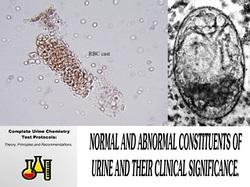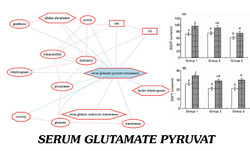NORMAL AND ABNORMAL CONSTITUENTS OF URINE AND THEIR CLINICAL SIGNIFICANCE.

Introduction : Urine is the Excreted product of the body formed by the kindly. The normal urine is formed by the glomerular filtration, tubular, reabsorption and tubular excretion
Introduction : Indicator of urine analisis :-
1. To diagnosis nephritic syndromes.
2. To diagnosis diabetes mediation.
3. To detect the type of jaundice.
4. To detect urinary tract infection.
5. To diagnosis pregnancy.
Composition : Tests for normal constituents of urine :-
Physical examination :
a. Volume : 1200-1500 ml/24 hours.
b. Colour : Straw or pale yellow.
c. Appearance : Transparent.
d. Reaction : Usually acidic ( 6.4-6.8 )
e. Specific : 1.003-1.030
Composition :
a. Water : 1200ml/day
b. Solid : 60gm/day
c. Organic : 5gm/day
d. Inorganic : 25/day
Inorganic ( Daily excretion in gm )
Orgonic ( gm/24 hours )Catior
Anion
Nitrogenous
Non-nitrogenous
Chemical examination :
a. Collection of Urine sample
b. Deter Mention of specific gravity,
Specific Gravity of urine is Determined by :-
1. test for cl : 2ml of
2. Test for PO4-3 :
Heat coagulation test:2/3 of test tube is filled with urine & upper part of its heated.4. molybded solution & a few drop of HNO3 acid is added & heated carefully.6. Test for urwa : 2ml of urine is taken in test tube. Then 3ml of saturated solution of Na0h & 2ml of Bromine water are added to it. 8.Test for uric acid : Small amount of urine is taken on a porecelin basin, 3 drops of concent-rated Hiv03 is added to it. It is carefully evaporated to lryness on a water bath or over a low flame. After being added 1 Drop of very diluted Nh40h is added to it.Observation :
1.Precipitation of white is AgNo3 formed that is soluble in NH4O.2. Turbidity appears but disappears when little amount of glacial acltic acid is added. 3. Yellowish precipitation phosphor molybded is 4. fondled5. White precipitation of SO4-2 & PO4-3 Appears. PO4-3 being dissolved with HCL.6. Effervescence of nitrogen is present.7. A ruby red colour appears which turns yellow by adding acltic acid & it become green on heating. Orange or red colour appear which turns to yellow on addition of acltic acid (dew to formation of creatine picrate )
8. -------------------Interance :
1.Cl is present.2. PO4-3 is present.3. PO4-3 is present4. ------------5. SO4-2 is Present.6. Urea is present in urine 7.Creatinine is present
8. Uric acid present Urine.
Introduction : Indicator of urine analisis :-
1. To diagnosis nephritic syndromes.
2. To diagnosis diabetes mediation.
3. To detect the type of jaundice.
4. To detect urinary tract infection.
5. To diagnosis pregnancy.
Composition : Tests for normal constituents of urine :-
Physical examination :
a. Volume : 1200-1500 ml/24 hours.
b. Colour : Straw or pale yellow.
c. Appearance : Transparent.
d. Reaction : Usually acidic ( 6.4-6.8 )
e. Specific : 1.003-1.030
Composition :
a. Water : 1200ml/day
b. Solid : 60gm/day
c. Organic : 5gm/day
d. Inorganic : 25/day
Inorganic ( Daily excretion in gm )
Orgonic ( gm/24 hours )Catior
Anion
Nitrogenous
Non-nitrogenous
Chemical examination :
a. Collection of Urine sample
b. Deter Mention of specific gravity,
Specific Gravity of urine is Determined by :-
1. test for cl : 2ml of
2. Test for PO4-3 :
Heat coagulation test:2/3 of test tube is filled with urine & upper part of its heated.4. molybded solution & a few drop of HNO3 acid is added & heated carefully.6. Test for urwa : 2ml of urine is taken in test tube. Then 3ml of saturated solution of Na0h & 2ml of Bromine water are added to it. 8.Test for uric acid : Small amount of urine is taken on a porecelin basin, 3 drops of concent-rated Hiv03 is added to it. It is carefully evaporated to lryness on a water bath or over a low flame. After being added 1 Drop of very diluted Nh40h is added to it.Observation :
1.Precipitation of white is AgNo3 formed that is soluble in NH4O.2. Turbidity appears but disappears when little amount of glacial acltic acid is added. 3. Yellowish precipitation phosphor molybded is 4. fondled5. White precipitation of SO4-2 & PO4-3 Appears. PO4-3 being dissolved with HCL.6. Effervescence of nitrogen is present.7. A ruby red colour appears which turns yellow by adding acltic acid & it become green on heating. Orange or red colour appear which turns to yellow on addition of acltic acid (dew to formation of creatine picrate )
8. -------------------Interance :
1.Cl is present.2. PO4-3 is present.3. PO4-3 is present4. ------------5. SO4-2 is Present.6. Urea is present in urine 7.Creatinine is present
8. Uric acid present Urine.
SERUM GLUTAMATE PYRUVATE TRANSAMILASE ACTIVITY IN SERUM.

Principle: SGPT converts alanine & xketoglutarate to pyruvate & glutamate. The pyruvate which is formal is measured in its derivatives form 2,4 dinitrophenyl hydrazine.
Alanine + x-ketoglutarateSGPT pyruvate & glutamate
Pyruvate + 2,4-dinitrophenyl hydrazine -----?
2,4- dinitrophenyl hydrazine.
Method: Reitman & frankles method.
Requirements:
a. Reagent II : ALT/SGPT
Composition: alamine
Xketoglutarate
Phosphate buffer
PH-7.5
Reagent II:
Composition: 2,4- dinitrophenyl hydrazine
Reagent IV: pyruvate standard.
b. Apparatus:
test tube
cuvette
pipette
Micropipette
Centrifuge machine
Colorimeter
Blood tournicate
Disposable syringe
Filter
Sample: serum
Procedure:
Arranged five cuvette and marked them 1,2,3,4,5
Addition sequence 1 2 3 4 5
Enzymatic activity O U/ml 25u/ml 50u/ml 83u/ml 120u/ml
Distilled water 100ml 100ml 100ml 100ml 100ml
Reagent II 500ml 450ml 400ml 350ml 300ml
Reagent IV 0ml 50ml 100ml 150ml 200ml
Reagent III 500ml 500ml 500ml 500ml 500ml
Mixed towel & allowed to stand at room temperature for 20 minutes.
1 2 3 4 5
Na0H 5000ml 5000ml 5000ml 5000ml 5000ml
Mixed well &allowed stand at roomtemprature for 5 minutes & measure the absorbance of cubettes 2-5, against 1.plot the graph of the absorbance of cuvette on the y axis vs the corresponding enzyme activity on x-axis.
Arrange one cuvette & marked them test.
Additional sequence – test
Reagent II - 500ml
Theem incuvetted for 5 minutes at 37oC
Serum - 100ml
Mixed & incuvetted well for 30 minutes at 37oC.
Reagent III - 500ml
Mixed well and allowed to stand at room temperature for 20 minutes.
Na0H - 500ml.
Measured the absorbance of test against distilled water & read the enzymatic activity.the supplied sample from the calibration curved ploted carlier.
Assay:
Wavelength : 505nm
Optical pathway : 1cm
Temperature : 37oC at roomtemparature.
Measured against distilled water.
Result:
Name of the student : abv musabbin
Age : 20
sex : male
Alt level is : 47.5u/ml
Normal level is : 45u/ml
Comment: ALT level is above normal.
Precaution:
1. Blood should be drawn with aceptic precaution.
2. Centrifugation should be completed properl.
3. Appropriate filter should be used.
Alanine + x-ketoglutarateSGPT pyruvate & glutamate
Pyruvate + 2,4-dinitrophenyl hydrazine -----?
2,4- dinitrophenyl hydrazine.
Method: Reitman & frankles method.
Requirements:
a. Reagent II : ALT/SGPT
Composition: alamine
Xketoglutarate
Phosphate buffer
PH-7.5
Reagent II:
Composition: 2,4- dinitrophenyl hydrazine
Reagent IV: pyruvate standard.
b. Apparatus:
test tube
cuvette
pipette
Micropipette
Centrifuge machine
Colorimeter
Blood tournicate
Disposable syringe
Filter
Sample: serum
Procedure:
Arranged five cuvette and marked them 1,2,3,4,5
Addition sequence 1 2 3 4 5
Enzymatic activity O U/ml 25u/ml 50u/ml 83u/ml 120u/ml
Distilled water 100ml 100ml 100ml 100ml 100ml
Reagent II 500ml 450ml 400ml 350ml 300ml
Reagent IV 0ml 50ml 100ml 150ml 200ml
Reagent III 500ml 500ml 500ml 500ml 500ml
Mixed towel & allowed to stand at room temperature for 20 minutes.
1 2 3 4 5
Na0H 5000ml 5000ml 5000ml 5000ml 5000ml
Mixed well &allowed stand at roomtemprature for 5 minutes & measure the absorbance of cubettes 2-5, against 1.plot the graph of the absorbance of cuvette on the y axis vs the corresponding enzyme activity on x-axis.
Arrange one cuvette & marked them test.
Additional sequence – test
Reagent II - 500ml
Theem incuvetted for 5 minutes at 37oC
Serum - 100ml
Mixed & incuvetted well for 30 minutes at 37oC.
Reagent III - 500ml
Mixed well and allowed to stand at room temperature for 20 minutes.
Na0H - 500ml.
Measured the absorbance of test against distilled water & read the enzymatic activity.the supplied sample from the calibration curved ploted carlier.
Assay:
Wavelength : 505nm
Optical pathway : 1cm
Temperature : 37oC at roomtemparature.
Measured against distilled water.
Result:
Name of the student : abv musabbin
Age : 20
sex : male
Alt level is : 47.5u/ml
Normal level is : 45u/ml
Comment: ALT level is above normal.
Precaution:
1. Blood should be drawn with aceptic precaution.
2. Centrifugation should be completed properl.
3. Appropriate filter should be used.
